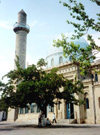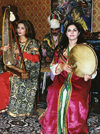 Following
their ambigous geographic location, Azeris have their feet in both Islamic
and European cultures, the latter mostly Russian and Turkish, struggling
with deep divisions between the old and the new. About 90% of the population
is ethnic Azeri, with a smattering of Dagestanis, Russians, Armenians,
Jews and other groups.
Following
their ambigous geographic location, Azeris have their feet in both Islamic
and European cultures, the latter mostly Russian and Turkish, struggling
with deep divisions between the old and the new. About 90% of the population
is ethnic Azeri, with a smattering of Dagestanis, Russians, Armenians,
Jews and other groups.
Most Azeris speak Azeri, a close cousin of Turkish, though many also speak Russian. The younger generation is now very keen to learn English. Even more than with Turkey, the 7 million Azeris living in the Republic of Azerbaijan feel closer to the 10 million (more islamicized) Azeris living in Iran, in what is usually called "South Azerbaijan".
![]() Although
at state level there is no conflict, there are movements in civil society
on both sides of the border, advocating a united Azerbaijan. A literature
of "longing" for reunification has also developed during the last half
century (e.g the works by Mirza Ibrahimov, Balash Azeruglu or by Suleyman
Rustam), with a folklore based in recent heroes, such as Semed Behrangi
and Jafar Pishevari.
Although
at state level there is no conflict, there are movements in civil society
on both sides of the border, advocating a united Azerbaijan. A literature
of "longing" for reunification has also developed during the last half
century (e.g the works by Mirza Ibrahimov, Balash Azeruglu or by Suleyman
Rustam), with a folklore based in recent heroes, such as Semed Behrangi
and Jafar Pishevari.
 Despite
years of Soviet attempts to wipe it out, Islam remains the most
popular religion with the Azeris, followed distantly
by various Orthodox Christian branches. Like in Iran, the majority of Azeris
are Shia Muslims (70%), whereas Sunni Muslims make up most of the Islamic
population of the rest of the former Soviet Union.
Despite
years of Soviet attempts to wipe it out, Islam remains the most
popular religion with the Azeris, followed distantly
by various Orthodox Christian branches. Like in Iran, the majority of Azeris
are Shia Muslims (70%), whereas Sunni Muslims make up most of the Islamic
population of the rest of the former Soviet Union.
Sunnis, the more secular branch, practice leadership by consensus, whereas Shia leadership derives its authority by divine right. In spite of the divisions elsewhere, in a spirit of tolerance, the mosques in Baku serve both the Shia and the Sunni communities. The Azeri Shia community practices the Jafarite rite.
Azerbaijan is one of the most liberal Muslim-majority states, although arranged marriages are common among the urban population, and marriage via kidnaping is not rare in the country side. There is an attempt by foreigners (Iranians, Pakistanis, Saudis, ...) to introduce Islamic fundamentalism.
 The
country's musical traditions are preserved by ashugs, or poet-singers,
who often strum the kobuz (a stringed instrument) while singing
of the deeds of ancient heroes. Another popular form of music in Azerbaijan
is mugam, which is improvised by voice and wind and stringed instruments
and is often compared to jazz.
The
country's musical traditions are preserved by ashugs, or poet-singers,
who often strum the kobuz (a stringed instrument) while singing
of the deeds of ancient heroes. Another popular form of music in Azerbaijan
is mugam, which is improvised by voice and wind and stringed instruments
and is often compared to jazz.
The country has a healthy literary heritage, much of which derives from an oral tradition of poems and ancient epics (e.g. by Nizami). Mirza Fath Ali Akhundzada was a literary light in the 19th century, helping to develop a modern literature, especially in drama. During Stalin's reign, many of the country's writers and artists were victims of the purge.
Azeri architecture went through many different stages over the centuries but the lasting legacies belong to the medieval period, especially the Maiden Tower and the palace of the Shirvan shahs in Baku. The capital's ornately decorated subway stations are its most recent architectural marvels.
 Azerbaijan
is famous for its carpets, but also for its
embroidered textiles. Artists use colourful threads (sometimes made of
gold or silver) and beads to create geometric patterns on a thin wool fabric
called tirme. The country's many bright-plumed birds and other animals
have also featured in designs. Other popular Azerbaijani textiles include
rugs, veils, shawls and towels.
Azerbaijan
is famous for its carpets, but also for its
embroidered textiles. Artists use colourful threads (sometimes made of
gold or silver) and beads to create geometric patterns on a thin wool fabric
called tirme. The country's many bright-plumed birds and other animals
have also featured in designs. Other popular Azerbaijani textiles include
rugs, veils, shawls and towels.
Azeris are good fans of the 7th art, and cinema made at the Azerbaijan Studios in Baku reached international prominence during the Soviet period, however difficulties after independence reduced significantly the number of Azeri feature films.